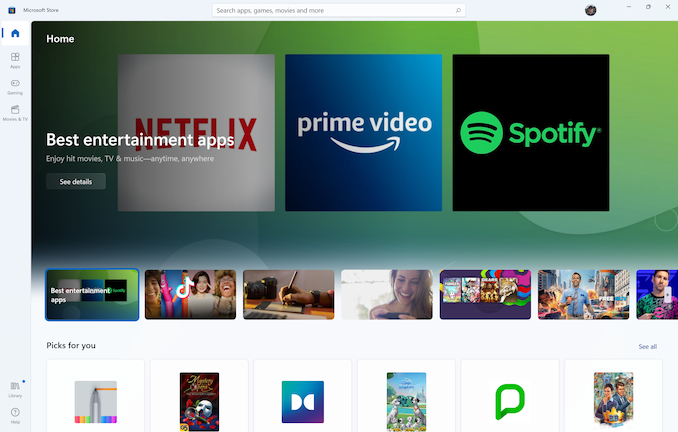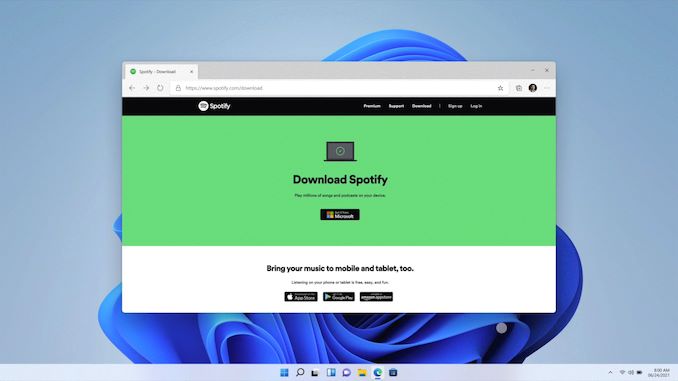What to Expect with Windows 11: A Day One Hands-On
by Brett Howse on October 4, 2021 4:00 PM EST- Posted in
- Software
- Operating Systems
- Windows
- Microsoft
- Windows 11
Microsoft Store
There are some big changes to the Microsoft Store model, although not all of them will be available at launch. Microsoft is dramatically changing their policies on what can go in the store, which should open the store up to more applications. Unlike the user interface changes though, the new store features/policies will be applied to Windows 10 as well.
When the Microsoft Store first appeared in Windows, it forced developers to utilize what eventually became known as Universal Windows Platform applications, or UWP apps. That nomenclature has morphed over time, and eventually Microsoft created methods for developers to publish more traditional Win32 applications in the store as well. The Windows 11 store dramatically expands this, allowing developers to publish any application built in any framework. Win32, .NET, UWP, Xamarin, Electron. React Native, Java, and of course Progressive Web Apps are now all supported frameworks in the store. This should immediately make the store much more useful to all users.
Microsoft is also changing the revenue share that they take from developers, perhaps inspired by some of the angst and anger directed at Apple’s App Store. The revenue share is now 85/15 for the developer for applications, and 88/12 for games. What’s more, if application developers bring their own e-commerce platform to their applications, whether one that is in-house or a third party one, Microsoft will take none of the revenue. In addition, Microsoft will be allowing stores within their store, so for example, Epic Games will be available through the Microsoft Store, but Microsoft will not take any of the revenue from Epic for any games sold. The only exception to these rules are video games distributed through the store – game developers will have to give Microsoft a cut regardless, which is perhaps not too surprising given that games are the single largest source of revenue on any of the app store platforms.
Overall, these are dramatic changes and should help the Microsoft Store be a place where people can actually find the apps they want and need. Which not only simplifies the install for the user, but provides a safety net compared to installing random software off the internet.
To be fair, Microsoft is not making these changes because they are a kind, generous company. They are making these changes to try to help the Microsoft Store compete. If applications do not show up in the store now, there seems to be little more they will be able to do to convince developers.
Android Apps on Windows
One of the biggest announcements for Windows 11 is Android application support, and Microsoft will be partnering with the Amazon App store to provide these applications. The underlying technology to support Android applications will be very similar to the Windows Subsystem for Linux, and will be called the Windows Subsystem for Android.
This is another key play for Microsoft to expand Windows 11 and bring additional functionality. Although Microsoft has supported tablet-style applications in Windows since Windows 8, they have never achieved very much developer support. That being said, Android tablet applications have never taken off in a way that most would have expected – Android tablets are predominantly used as portable TVs, as opposed to productivity devices – so we will have to wait and see if this is as big of a deal as promised.
The bad news is that, like many of the promised features for Windows 11, this is not available on launch day, and is scheduled to be available some time in 2022.
Install Apps from the Web
To simplify the experience, Microsoft will also be supporting a simplified install via pop-up on the web for sites that have apps in the store. This is something that other operating systems already support, but still nice to see.













95 Comments
View All Comments
alpha754293 - Monday, October 11, 2021 - link
XP WAS good. But I just tried to virtualise XP with a quad-core processor, and XP could recognise multiple cores in multi-socketed systems, but if I set my XP VM with 4 cores from my Core i7-8559U, XP doesn't know what to do with it (though I wished that it did).XP WAS fast, but with its age, also shows its limitations as well.
GeoffreyA - Monday, October 11, 2021 - link
XP has aged considerably but it'll go down in history as a classic. Possibly the best Windows ever made.Oxford Guy - Monday, October 4, 2021 - link
‘t looks amazing! Finally good tastes in a Windows UI.’A superficial coat of paint doesn’t justify a new OS, especially one that bans high-performance highly-relevant hardware.
Oxford Guy - Monday, October 4, 2021 - link
‘So it raises the question: Why now?’MS wants to see if it can copy Apple’s extreme planned obsolescence routine, one-upping the company by making it more egregious.
High-performance hardware is being banned so MS and hardware vendors can shake people down.
Windows 11 does not offer enough value to be a product for consumers. It’s a product by and for MS, with the company betting that passivity will ge enough — which, of course, it will.
Both companies have insanely high valuations precisely because consumers are so passive. They’ll trade value for laziness over and over again.
GeoffreyA - Monday, October 4, 2021 - link
I had been thinking about giving 11 a try, but of late am just not interested any more. Windows 10 works all right, so why create more headache? And 11 seems ambitious of following in the illustrious footsteps of Vista and 8.Silver5urfer - Monday, October 4, 2021 - link
Simple - MONEY.Intel has new BS biglittle copycat on x86 to combat the AMD and Apple processors and they have a huge say in the x86 world simply because of how their Server Marketshare is, 90%+ And now note how Win11 SAC is no more, it's AC, basically Win10 is Semi Annual Channel releases and Win11 abandoned it for Annual releases. A big relax for the MS, yeah users are beta testers for a long time but this helps them and that secures their new Win11 licensing systems.
Now there might be a question why the new systems and all, x86 products that Intel sells are more in Laptop BGA trash ware not DIY, and Servers are top ofc. With these new thin and light devices selling in volumes, remember how Chrome OS and Chromebooks had a huge boost ? People are getting dumber and dumber so they are fine with yearly trash refreshes of Smartphones for $1000 and same for laptops, shiny new toy.
And finally Windows team at M$ was abandoned long back in 2018 itself, the guy who was at MS responsible for the division was laid off and then Office / Cloud teams took over it, they started adding without any direction, which became the abomination called Win10 a mish mash of garbage new UI and solid Win32 both shoved together. M$ wants to get rid of all that baggage, so they made Panos Panay the dumb idiot who barely even knows what is an OS as head because Surface garbage to combat Apple tablets and other touch screen ecosystem. Remember this is highest volume of x86 shipments.
Ultimately because of that new UI was made, watch the video of the fools who worked on it, basically when MS orphaned Windows team internally it was fractured heavily with all that Win10X Windows S and other garbage so the reason why it looks so garbage and anti desktop because the people who worked on the management and directing this dumpster which kills all Taskbar behavior and so many Win32 features removed are simply and they all are addicted to Apple mediocrity and poor dumb UX, that bled to Win11 UX. But Nadella focus is to make money, so they had the Xbox Gamepass and others, which is why the Store had a revamp and massive focus to make it centralized Win32/UWP repo, Windows have decentralized system of software distribution which makes it superior to Linux in my eyes, no BS dependencies to download or anything, simply can be found on internet due to Win32 flexibility.
Final piece of puzzle TPM, why ? Again money, Intel and AMD and other OEMs can mint money due to the offloaded cost to Consumer citing new DRAM DDR5, Big little marketing (Intel) and others and get Win11 licensing, on top their entire Office suite is as a Service, basically everything is as a service. They even announced the DaaS. Now the TPM, with Win10 extensive propaganda level push GWX, forced updates on everyone and constant spying and nagware MS got all the data they need for NSA and Patriot Act in US and world wide data mining. Who controls the data controls the world - MS, Amazon, Google, Apple, FB the giant goliaths. So now they do not need the old husk of machines simply break them officially by introducing the TPM hard requirement. It's using Secure Boot and TPM when both combine Windows Defender can even scan the BIOS, check Defender ATP page, they give this exact requirement to get BIOS scanning. Oh also they will abandon CSM on BIOS side, it was scheduled for 2020 got delayed, now I bet no Z690 and X670 boards will have CSM anymore, more UEFI licensing by MS, no more Windows 7. Plus TPM gets them even more data and control. Win11 home doesn't even work without MS Account.
This POS dumpster OS should be avoided by any sane person. Win10 is better esp if you can get hands on LTSC and debloat it to basics, there's a new 2021 LTSC also coming for Win10 stick to the Win10 it's better. Win11 RTM will be broken garbage and there's absolutely no need to install it either.
flyingpants265 - Monday, October 4, 2021 - link
I agree with most of this. In a few places I had no clue what you were talking about, but it sounds about right. Microsoft is just some company from the 90s, it makes no sense that they should have a global monopoly on operating systems or their user interface.I like the Windows interface. They have billions of dollars. They can improve it, make it work faster, better, more organized, and add more features. They are in a perfect position to do something good, but they just don't want to.
GeoffreyA - Tuesday, October 5, 2021 - link
I think this is a pattern with Microsoft: a disappointing OS, followed by a first-rate one. ME, XP, Vista, 7, 8, 10. By this logic, Windows 12 should be worthy of applause.TheinsanegamerN - Tuesday, October 5, 2021 - link
But 10 was a major dissapointment for most. 11 shoudl have been the good one.GeoffreyA - Thursday, October 7, 2021 - link
I hated then grew fond of 10 after using it at home, aided by customisation and keeping "Settings" locked up in the attic.